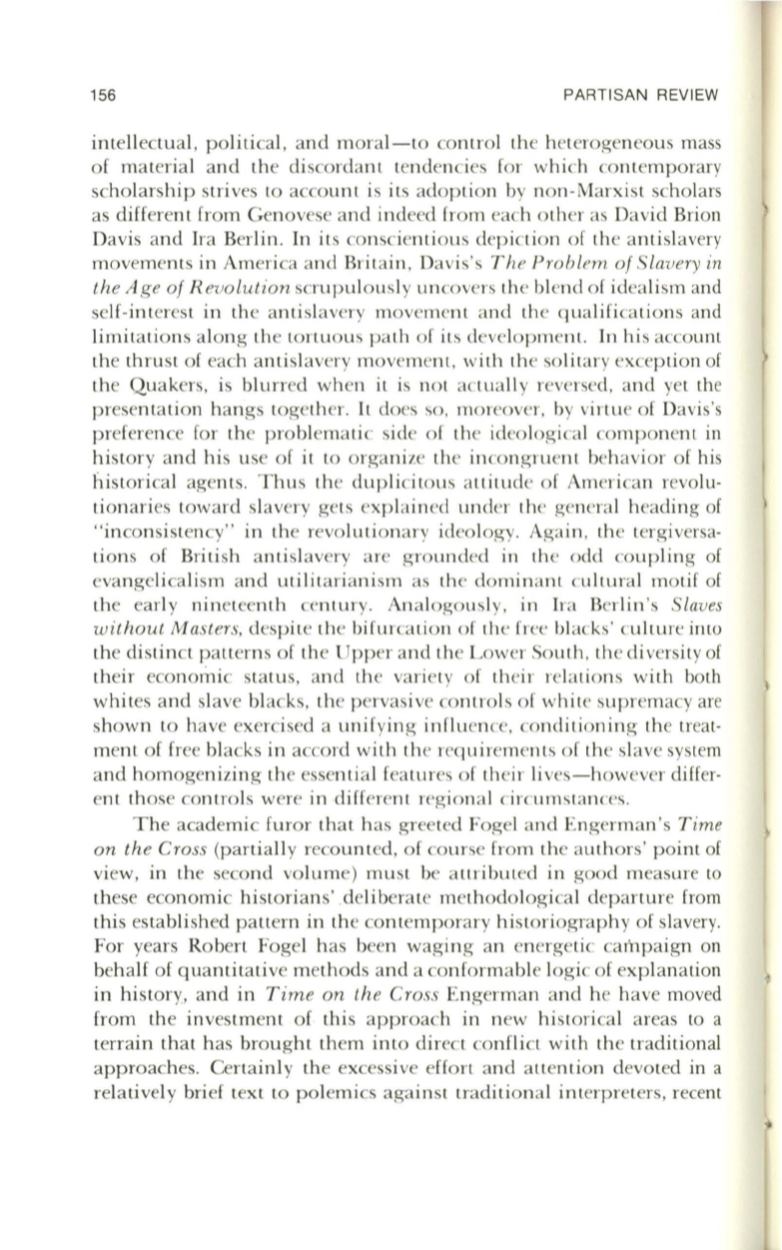
156
PARTISAN REVIEW
intell ectual, political, and moral-to control the heterogeneous mass
of ma teri a l and the di scordant tendencies for whi ch contemporary
scholarship strives to account is its ado ption by non -Ma rxi st scholars
as different from Genovese and indeed from each o ther as David Brion
Davi s and Ira Berlin.
In
its conscienti o us depi cti on of the anti slavery
movements in Ameri ca and Britain , Davi s's
The Problem of S lavery in
the Age of R evo lut ion
scrupul o usly un covers the blend of idea lism and
self-interes t in the anti slavery movement and th e qualifi ca ti ons and
limita tion s along th e tortuo us pa th of its development.
In
hi s account
the thrust of each anti slavery movement, with the so litary exception of
the Quakers, is blurred when it is not actuall y reversed , and yet the
presenta ti on hangs together.
It
does so, mo reover, by virtue of Davis 's
preferen ce for the probl ema ti c side of the ideo logical component in
hi story and hi s use of it to organi ze the in congruent behavi or of his
hi stori cal agents. Thus th e dupli citous altitude o f Ameri can revolu–
ti onari es toward slavery gets expl ain ed under the general heading of
" inconsistency" in the revo luti onary ideology. Aga in , the tergiversa–
ti ons of British anti slavery a re grounded in the odd coupling of
evangeli calism and utilita ri anism as the dominant cultural mo tif of
the earl y nineteenth century. An alogously, in Ira Berlin 's
Slaves
without Masters,
despite the bifurca ti on o f the free bl acks' culture into
the distinct pa tterns of the Upper and the Lower South , the di versity of
their economi c sta tus, and the va ri ety of their relat ions with both
whites and slave blacks, the pervas ive control s of white supremacy are
shown to have exercised a unifyin g influence, conditi oning the treat–
ment o f free bl acks in accord with the requirements of th e slave sys tem
and homogenizin g the essenti al fea tures o f th eir li ves -however differ–
ent those control s were in different regiona l circumstances.
The academi c furor tha t has greeted Foge l and Engerman 's
T ime
on the Cross
(parti all y recounted, of course from the authors' point of
view, in the second volume) mu st be a ttributed in good measure to
these economic hi stori ans' .delibera te methodo logical departure from
this established pa ttern in the contempora ry histori ography of slavery.
For years Robert Fogel has been waging an energeti c campaign on
behalf of quantita tive methods and a conforma ble logic of expl anation
in history, and in
T im e on the Cross
Engerman and he have moved
from the investment of thi s approach in new hi stori cal areas
to
a
terrain that has brought them into direc t confli ct with the traditional
approaches. Certainl y the excessive effo rt and a ttenti on devoted in a
rela tively brief text to polemics aga inst traditi onal interpreters, recent


